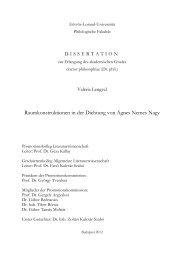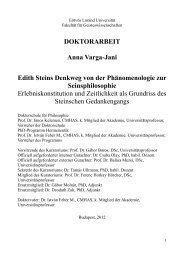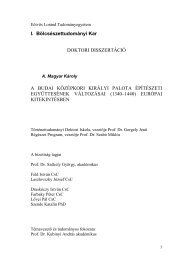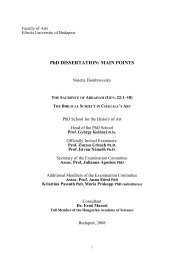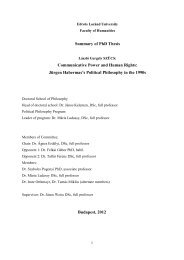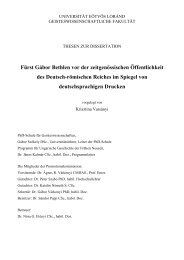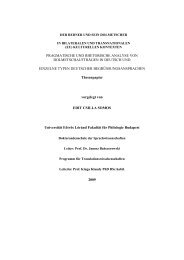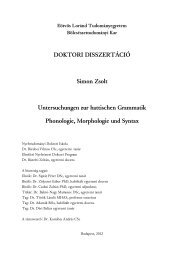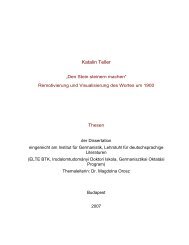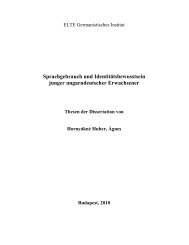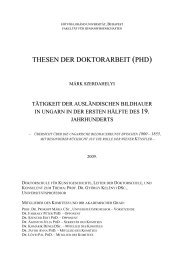EMŐKE RITA SZILÁGYI - ELTE BTK disszertációk
EMŐKE RITA SZILÁGYI - ELTE BTK disszertációk
EMŐKE RITA SZILÁGYI - ELTE BTK disszertációk
Create successful ePaper yourself
Turn your PDF publications into a flip-book with our unique Google optimized e-Paper software.
Eötvös Loránd University<br />
Faculty of Humanities<br />
PHD THESES<br />
<strong>EMŐKE</strong> <strong>RITA</strong> <strong>SZILÁGYI</strong><br />
ON THE PATRONAGE OF JÁNOS VITÉZ<br />
JOHANNES TRÖSTER AND THE 1450’S<br />
Doctoral School of Literary Studies<br />
Director of the Doctoral School: Géza KÁLLAY (PhD)<br />
Programm for European and Hungarian Renaissance<br />
Director of Programme: Iván HORVÁTH (DSc)<br />
Members of Committee:<br />
Balázs DÉRI (PhD) Chair<br />
László JANKOVITS (PhD) Opposer<br />
Géza SZENTMÁRTONI SZABÓ (PhD) Opposer<br />
László SZÖRÉNYI (DSc) Member<br />
István DRASKÓCZY (DSc) Member<br />
Gyula MAYER (PhD) Member<br />
Ábel TAMÁS (PhD) Secretary<br />
Supervisors:<br />
Iván HORVÁTH (DSc)<br />
Farkas Gábor KISS (PhD)<br />
Budapest, 2013<br />
1
The aim of this paper is to provide a fresh and more nuanced portrait of the patronage of ”the<br />
Father of Hungarian Humanism” as well as the birth of Transalpian humanism and its<br />
bearings on Hungary by examinig the narrative sources on the maecenatism of János Vitéz.<br />
What called for the elaboration of this topic was not only the fact that, so far, we know of no<br />
comprehensive account of the findings these scripts of various origins have shed light on, but<br />
also the enticing prospect that the thorough recapitulation of both earlier and recent ideas<br />
allows of acquiring a fresher, more up-to-date profile of the patron than the one suggested by<br />
Vilmos Fraknói. The nature and aspects of Vitéz’s humanism have been disputed for decades.<br />
Since I am convinced that it is by surveying his work as a patron that his acitvities related to<br />
humanism (literary patronage, textual emendations and other innovations in philology,<br />
establishing libraries, educational activities, etc.) can be understood.<br />
In addition to all these, his political and diplomatic work can also be connected to his work<br />
as a patron, thus yielding assistance for the delineation of an even more realistic image.<br />
My paper begins with a general introduction, in which I briefly describe the sources,<br />
forums and ways of implementations of fifteenth-century humanism (I.). This introduction<br />
seemed essential in order to serve as a handhold for the reader by mustering the topics and<br />
activities which are to occur hereafter, thus showing a preliminary view of fifteenth-century<br />
humanism. Enea Silvio Piccolomini (later Pope Pius II), who managed to obtain both political<br />
and cultural primacy in the 1440’s and 1450’s, played a crucial role in the birth of Transalpine<br />
humanism (II.) His friendship, correspondence, and common interests with János Vitéz, such<br />
as the organization of a war against the Ottomans or the supporting of the young, are<br />
surpassingly important topics in the investigating the roots and birth of Hungarian humanism.<br />
Besides Piccolomini, Cardinal Bessarion and Leonard Huntpichler can be identified as some<br />
of the most significant role models of Vitéz. This makes it obvious to assume long-term<br />
connections with and some most determining friendships from Vienna. The paper’s extensive<br />
central chapter (III.3.) enumerates scholars, friends, and relatives of Vitéz, with an attempt to<br />
arrange them in a way that not only the chronological order, but also a whole network of<br />
relationships can be seen. The above-mentioned personalities were either granted literary<br />
patronage or supported by Vitéz backing their studies and then securing them a place at the<br />
chancellery. These supportive activities can scarcely be separated from each other: studies in<br />
Italy could be followed by positions held at the chancellary (Miklós Bánfalvi, István Bajoni,<br />
etc.), graduates with their own writings and/or references from a Maecenatulus went to win<br />
his favors and managed to obtain positions (Johannes Tröster, Nicolaus Liscius, György<br />
2
Kosztolányi [Polycarpus], etc.), but it is also common that his subvention can only be inferred<br />
from posterior acknowledgements (Galeotto Marzio, Nicolaus Modrusiensis, Jacobus<br />
Publicius…stb.). In most cases, there were two ways of approaching him: one was through the<br />
Viennese connections, that is, with the mediation of Piccolomini and Huntpichler, and the<br />
other one was via his ex-protégés studying in Ferrara, that is, via Janus Pannonius and György<br />
Kosztolányi (Polycarpus). The linkage between these two coteries was not only Vitéz’s<br />
personality but also that of Johannes Tröster, to the presentation of whom the second half of<br />
my paper is dedicated.<br />
The novelty of the dissertation is the presentation of Johannes Tröster, a Bavarian humanist<br />
and lesser-known protégé of János Vitéz and a study of their maecenatic relationship (IV.),<br />
which is followed by an analytic review of his Dialogus de remedio amoris (V.), a work<br />
dedicated and tailored to the taste of Vitéz. The lack of a critical edition of this literary work –<br />
with more than one versions from the author – has long been a shortcoming of the<br />
international research on humanism, not to mention that its Hungarian relations make it a<br />
deserving subject of research, analysis and interpretation in Hungary, as well. The author,<br />
Tröster, was the preceptor of King Ladislaus V, then, following the elopement putsch of 1452,<br />
he finally managed to obtain a job in 1454, when his master Enea Silvio Piccolomini<br />
commended him to his friend János Vitéz. In all probability, he performed diplomatic tasks at<br />
the service of Vitéz between 1454 and 1457. Though there are no written records of<br />
correspondence or any literary activity related to Tröster from this period, he apparently<br />
preserved his previous relationships, which was certainly a great benefit for Vitéz, as well.<br />
Since the period between 1454 and 1457 bore the burden of both foreign and internal<br />
skirmishes, Vitéz was in desperate need for a reliable intermediary with his Viennese<br />
relations. Besides, Tröster’s friendship with Janus Pannonius, György Kosztolányi<br />
(Polycarpus) and Simon Hungarus in Hungary also show that the Bavarian humanist had<br />
multiple ties to the then nascent Hungarian humanism.<br />
The main objective of my dissertation is to map and systhematize the maecenatic system<br />
connected to Vitéz, and also to get a better understaning of the nature and working of<br />
patronage. On charting the networks of these relationships, also involving Johannes Tröster in<br />
the research, my findings can be summarized in the following statements about the patronage<br />
of János Vitéz:<br />
1. Vitéz’s humanism can best be approcahed, interpreted, and understood by examining his<br />
maecenatic work.<br />
3
2. While establishing his system of patronage, he used both inherited and newly devised<br />
ways, the most important of the latter being his connections in Vienna and Italy (the latter via<br />
Janus Pannonius and Kosztolányi [Polycarpus] György). The reasons for his tight relations<br />
with Vienna are both political and personal. Vienna was home to the imperatorial chancellary,<br />
where he had to settle everyday matters. In addition, he attended university there, like most of<br />
his pen-friends and protégés. It seems that the Italian connections gained importance from the<br />
late 1450’s. In the beginning, the ’Viennese way’ proved more prominent.<br />
3. Vitéz’s patronage was a particularly extensive one, embracing many fields of life: from<br />
art and literary patronage to educational reforms. Since we can scarcely speak of art patronage<br />
in the 1450’s – as its invigoration probably began after the marriage of Matthias Corvinus and<br />
Beatrice of Naples – his prevailing motivations in patronage were of literary, educational and<br />
political nature.<br />
4. The various forms of seeking a patron evolved until the fifteenth century are also present<br />
in Vitéz’s patronage system. As I explain in detail – largely relying on Beccadelli –there was<br />
often the need for a third person, an intermediary or agent, a so-called Maecenatulus, who<br />
would act as a mediator between supporter and supported. In Vitéz’s case it was usually<br />
Piccolomini who assumed this role. Such ’role plays’ remained in fashion in later humanist<br />
literature as well, and there are also interesting accounts of Vitéz, Piccolomini, and the<br />
Viennese friends identifying with the roles they assumed in their letters: Vitéz would appear<br />
as Maecenas, Piccolomini as Virgil, Tröster as Horace, Ladislaus V as Augustus, Castelbarcus<br />
as Ascplepios, etc. Considering the fact that Beccadelli was a contemporary of Vitéz and a<br />
friend of Piccolomini, it may not be an exaggeration to assume an almost identical system and<br />
culture of patronage.<br />
5. It is not only the system of patronage where these common traits can be traced, but also<br />
the literary allusions and common sources and vocabulary which connect Janus, Vitéz,<br />
Tröster, and the humanist coterie in Vienna on the basis of their works and correspondence. In<br />
my paper I quote numerous accounts of the usage of common vocabulary and means of<br />
expression, which serve as a proof of the fact that not only did they know each other’s<br />
writings, but they were also eager to exhibit this by explicit indications.<br />
6. The works relating to Vitéz’s patronage abound in characteristics implying<br />
astronomical, medical, and literary interest, or some peculiar mixture of all these. Unlike<br />
indicated by the relevant secondary literature so far, Vitéz was not only interested in<br />
astronomy, but also in medical, philosophical and theological questions.<br />
4
7. Johannes Tröster – lesser-known in Hungary – was one of his protégés between 1454-<br />
1457. A version of his only known work, Dialogus de remedio amoris was sent to Vitéz, the<br />
aspired patron, accompanied by an enclosed letter of reference by Piccolomini. The<br />
presentation and processing of Tröster’s life, his years at Vitéz’s service, and his literary work<br />
is not only groundbreaking in the research of Hungarian humanism, but is also a fine example<br />
of how Vitéz’s patronage actually worked. This patronage – with regard to both its coming<br />
into being as well as it implementation – bears the traits typically present in Vitéz’s<br />
patronages of the 1450’s: the protégé reached Vitéz with the help of Piccolomini’s letter of<br />
reference and supposed dedication. The patron himself then made good use of Tröster’s<br />
writing and rhetorical skills as well as his political practice when employing him as a gobetween<br />
carrying his letters of commissions. Much as he acknowledged talent and the<br />
eagerness to write, Vitéz seems to have valued the practical use of studia humanitatis even<br />
more.<br />
The thorough presentation and reinterpretation of Vitéz’s patronage system by adding new<br />
aspects also proves an invaluable aid in revisiting his establishing libraries and founding<br />
Academia Istropolitana, other topical issues related to Vitéz’s humanism.<br />
5
PUBLICATIONS RELATED TO THE TOPIC OF THE THESES<br />
FONZIO 2011 = Bartolomeo della FONTE, De poenitentia, introduction and translation by<br />
Emőke Rita <strong>SZILÁGYI</strong> = „Margarita poetica”, A humanista alapműveltség olvasmányai<br />
a Kárpát-medencében 1526-ig: Antológia, („Margarita poetica”, Anthology of the<br />
Humanist Erudition in the Carpathians up to 1526 AD) ed. by Péter EKLER, Bp., OSZK<br />
– Gondolat Kiadó, 2011 (Nemzeti Téka, 222), 190–91.<br />
<strong>SZILÁGYI</strong> 2010 = Emőke Rita <strong>SZILÁGYI</strong>, Ajánlás bécsi módra: Enea Silvio Piccolomini<br />
ajánlólevele Johannes Trösterről Vitéz Jánosnak 1454 nyarán (A Viennese<br />
Recommendation, Recommendation Letter of Johannes Tröster to Johannes Vitéz, by<br />
Enea Silvio Piccolomini, Summer 1454) = Ghesaurus: Tanulmányok Szentmártoni<br />
Szabó Géza hatvanadik születésnapjára (Ghesaurus, Collection of Studies Dedicated to<br />
Géza Szentmártoni Szabó for his 60th Birthday), ed. by Rumen István CSÖRSZ, Bp.,<br />
rec.iti, 2010, 125–132.<br />
<strong>SZILÁGYI</strong> 2012a = Emőke Rita <strong>SZILÁGYI</strong>, Teucri sive Turci. Egy ideologikus elnevezés<br />
története a 15. századi latin nyelvű művekben (Teucri sive Turci. The History of an<br />
Ideological Denomination in the 15th Century Latin Literature) = Identitás és kultúra a<br />
török hódoltságban (Identity and Culture during the Ottoman Occupation) Proceedings,<br />
ed. by Pál ÁCS – Júlia SZÉKELY, Bp., Balassi Kiadó, 2012, 285–298.<br />
<strong>SZILÁGYI</strong> 2012b = Emőke Rita <strong>SZILÁGYI</strong>, Enea Silvio Piccolomini és Vitéz János levelezése az<br />
1450-es években (Correspondence between Enea Silvio Piccolomini and Johannes Vitéz<br />
in the 1450’s) = BÉKÉS – TEGYEY 2012, 195–205. (Classica – Mediaevalia – Neolatina<br />
VI.)<br />
<strong>SZILÁGYI</strong> 2012c = Emőke Rita <strong>SZILÁGYI</strong>, Antikvitás egy korai humanista műben: Johannes<br />
Tröster: Dialogus de remedio amoris (Antiquity in an Early Humanist Work, Dialogus<br />
de remedio amoris by Johannes Tröster), Ókor 11 (2012), 37–43.<br />
<strong>SZILÁGYI</strong> 2012d = Emőke Rita <strong>SZILÁGYI</strong>, Johannes de Kupferberg, az Academia Istropolitana<br />
tanára (Johannes de Kupferberg, a Professor of the Academia Istropolitana), MKSz<br />
128 (2012), 375–80.<br />
6



